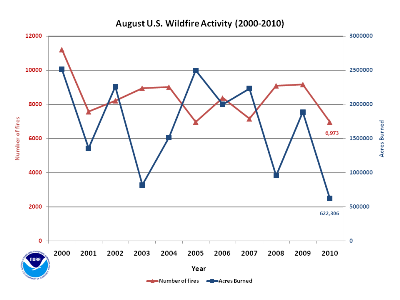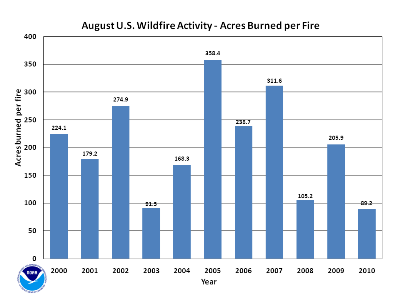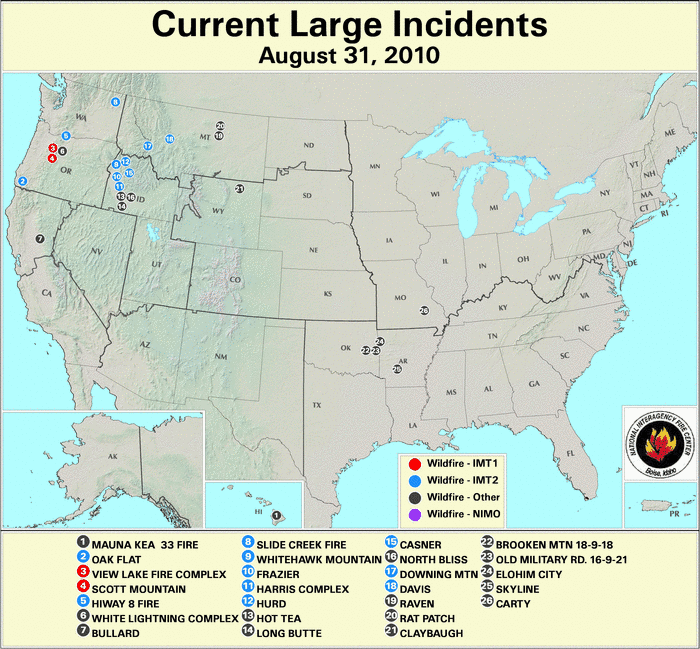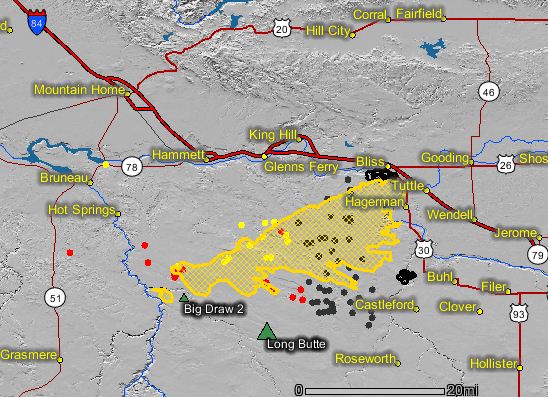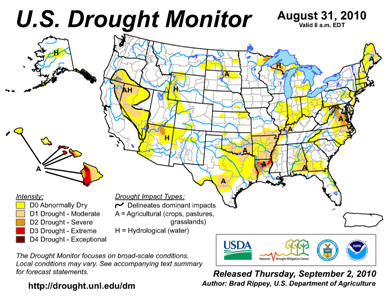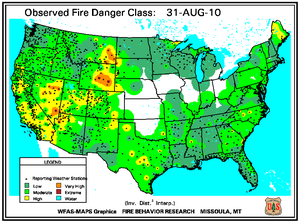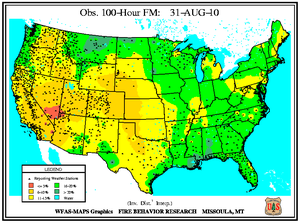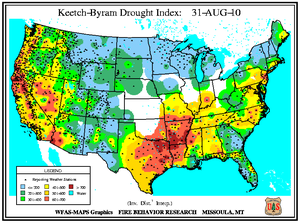Updated: 7 September 2010
*Data are for the period July 29th–August 31st, and are from the National Interagency Fire Center.
Throughout 2010 year–to–date, wildfire activity was relatively quiet. 2.6 million acres (1.05 million hectares) burned between January 1st and August 31st, which is less than half of the 10-year average for the period. Particularly in the continental U.S., fire activity has been unusually quiescent, with more than 40 percent of all U.S. acreage burned [1.1 million acres (0.4 million hectares)] having been in Alaska.
[ August 2
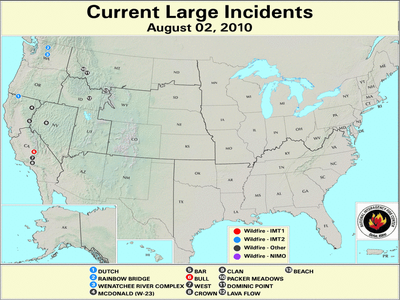 |
August 13
|
August 13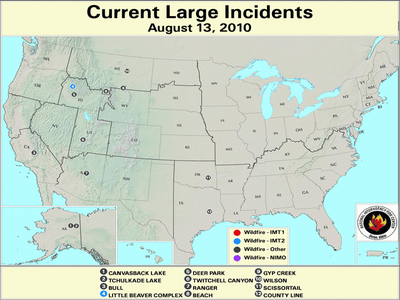 |
August 31
|
August 31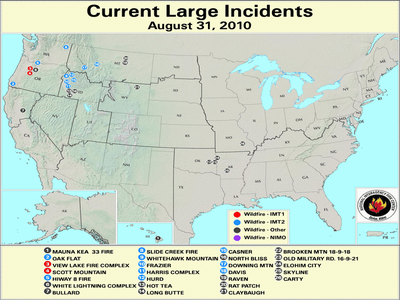 ]
]
During August, the nation as a whole was much warmer than normal and drier than normal. In the West, where the wildfire season is in full swing, temperatures and precipitation were closer to the long-term average. The past few months have brought a mixed bag of temperatures and precipitation to the region, which has had a large impact on the number of wildfires and the acreage burned during 2010. August brought a typical precipitation pattern to the U.S., with a hodgepodge of states having precipitation totals above and below normal. The lack of extremely hot or extremely dry weather in the West, where large fires are most common, has limited the acreage burned during the month. See the national temperature and precipitation State of the Climate report for additional information on temperatures and precipitation.
At the beginning of August, 13 large fires were active in the western United States — six in California; two in Montana and Washington; and one in Idaho, Nevada, and Wyoming. By mid–August, the number of large fires dropped to 12, with two fires burning in Alaska, Idaho, and Montana; and one fire in California, Arizona, Utah, Texas, Oklahoma, and Wyoming. Wildfire activity picked up significantly by the end of the month, particularly in the Northwest, with a total of 26 large fires active — nine in Idaho; five in Oregon; three in Montana; two in Oklahoma and Arkansas; and one each in California, Washington, Hawaii, Missouri, and Wyoming.
The Long Butte Fire near Hagerman, Idaho burned approximately 306,113 acres (123,880 hectares) over the course of a week. The fire began on August 21st due to a lightning strike and spread rapidly across the grasslands — an estimated 215,000 acres (87,000 hectares) burned on August 23rd alone. A cold front moving across the region brought dry conditions and strong winds, which fueled the rapid growth. A wind gust of 70 mph (113 km/hr) was measured nearby in Boise. The fire was fully contained by August 29th. The burn area included the home range of a wild horse herd and about 75 percent of the Hagerman Fossil Beds National Monument. The Long Butte Fire has been the largest fire observed in the U.S. during 2010. The second largest fire to–date was the Tolkat 2 Fire in Alaska, which burned 188,807 acres (76,407 hectares) in May and June.
The typically lush and wet Hawaiian Islands continued a long dry spell into August, creating conditions which were favorable for wildfires. A large fire near Mauna Kea State Park on the Big Island burned 1,386 acres (561 hectares) between August 22nd and 31st. At month’s end the fire was still only 60 percent contained, but weather conditions were expected to improve and provide additional aid to the firefighters. Investigators believe the fire was a product of arson, and an arrest was made in connection with the blaze.
2010 Wildfire Statistics
(Source: NIFC)| Year–To–Date Totals as of August 31st | Nationwide Number of Fires | Nationwide Number of Acres Burned |
|---|---|---|
| 08/31/2010 | 43,799 | 2,600,843 |
| 08/31/2009 | 63,832 | 5,147,710 |
| 08/31/2008 | 63,108 | 4,434,364 |
| 08/31/2007 | 63,799 | 6,854,854 |
| 08/31/2006 | 78,037 | 7,165,712 |
| 08/31/2005 | 44,181 | 6,818,389 |
| 08/31/2004 | 54,266 | 6,630,417 |
| 08/31/2003 | 43,373 | 2,556,710 |
| 08/31/2002 | 60,335 | 6,177,698 |
| 08/31/2001 | 56,670 | 2,840,500 |
| 08/31/2000 | 71,510 | 6,002,534 |
| 5–yr average (2005 – 2009) |
62,591 | 6,084,206 |
| 10–yr average (2000 – 2009) |
59,911 | 5,462,889 |
According to statistics from the National Interagency Fire Center (NIFC), at the end of August, the number of nationwide fires year–to–date was 43,799 which burned 2.6 million acres (1.05 million hectares) with an average of 59 acres (24 hectares) per fire. Between July 29th and August 31st, approximately 622,306 acres (251,838 hectares) burned across the U.S., which is 65 percent below the 2000-2009 average and marked the least August acreage burned since records began 2000. A total of 6,973 new fires were reported during the month, which is 18 percent below the 2000-2009 average and the smallest number of new August fires reported since 2000. The average number of acres burned per fire was 89 (36 hectares) during August and is 59 percent below the 2000-2009 average and the least acres burned per fire in the 11-year period of record.
According to the U.S. Drought Monitor, during August, the size of the overall drought footprint changed little — some regions experienced improving drought conditions while other locations had worsening drought conditions. Abnormally dry conditions became more widespread in the Northeast, while moderate drought developed in Maine and extended along Long Island and the New Jersey coast. Severe drought lessened to moderate on the Delmarva peninsula, but grew in eastern Virginia and parts of West Virginia. The southern Appalachians received much needed precipitation during the month, eliminating moderate drought there. Ongoing very dry and hot conditions in the Southeast, Lower Mississippi River Valley, and southern Plains allowed the continuation and expansion of moderate–to–extreme drought there. Monsoonal rains in the Southwest aided in the improvement of drought conditions in New Mexico and Arizona. Dry conditions continued for Hawaii, with 69 percent of the state experiencing drought at the end of August.
According to the U.S. Forest Service (USFS) Wildland Fire Assessment System, high fire danger was present almost entirely along and west of the Rockies on August 1st. Very high to extreme fire danger was present for most of Nevada. Dryness in Maine and Arkansas created very high fire danger by August 15th, and the high fire danger continued in the Great Basin and extended into southern California and parts of the Northwest. Very hot temperatures and dry weather brought high fire danger to central Texas by the end of the month. Very high fire danger was also reported in the high plains of Montana and Wyoming. The very high fire danger in the Great Basin and California improved slightly by the 31st due to scattered rain occurring in the region.
According to the USFS Wildland Fire Assessment System, the beginning of August brought low 10-hour fuel moistures to almost the entire country except for the upper and mid Mississippi River Valley where wet conditions prevailed during the previous month. 100-hour and 1,000-hour fuel moistures were mostly dry in the West, especially the Great Basin and southern California. By August 15th, wet conditions in the Northeast and Southeast moistened smaller fuels (10-hour and 100-hour fuel moistures), except in coastal North Carolina, Maine, and central Florida. Dry fuels of all sizes (10-hour, 100-hour, and 1,000 hour fuel moistures) were widespread from the Plains westward to the Pacific Coast. The driest fuels were present once again in the Great Basin and the Four corners region. At the end of the month, dry weather prevailed across most of the East. Dry 10-hour fuel moistures were present along most of the Atlantic Seaboard and eastern Great Lakes as well as the Southwest and High Plains. Medium (100-hour fuel moisture) and large (1,000-hour fuel moistures) size fuels were once again the driest across the interior West and the southern Plains. In Alaska, dry 10-hour and 100-hour fuel moistures persisted across the northern half of the state during August, while larger fuels (1,000-hour fuel moistures) remained moist.
According to the USFS Wildland Fire Assessment System, at the beginning of the month, high Keetch–Byram Drought Index (KBDI) values were present from New Jersey, stretching southward along the coast into northern Florida, and westward into northeast Texas, with the highest values in Louisiana where drought has been ongoing. Very high KBDI values were also present in the Southwest, stretching into Northern California and the Cascades. By mid-August, the high KBDI values worsened in the Mid-Atlantic, as well as the Lower Mississippi River Valley, while they persisted and remained unchanged in the West. KBDI values were even more elevated by the end of the month in the East and South, particularly in Arkansas, Texas, and Louisiana. KBDI values also increased in northern California and the Pacific Northwest. KBDI values remained low during the entire month across Alaska.
 NOAA's National Centers for Environmental Information
NOAA's National Centers for Environmental Information
